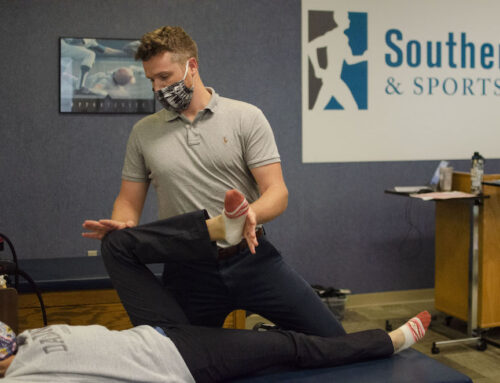What is Aquatic Therapy?
Aquatic Therapy is sometimes incorporated in a patient’s therapy plan to allow for functional movement during exercise. For patients who have joint pain or must avoid bearing weight on a joint, performing physical therapy in waist or chest deep water allows them to exercise while standing.
Many physical therapy exercises are performed with patients lying on a table, which is not representative of real-life movement. Getting into the pool allows them to exercise and move in a more natural way. The buoyancy of the water supports the body, decreasing the load on joints. In fact, standing in waist deep water removes about 50% of the weight from the knees and ankles, and chest deep water removes 75% of the weight from the hips, low back, and knees. This can accelerate recovery time from surgeries that typically require weeks without bearing weight on certain joints.
In addition to relieving the joints from bearing weight, aquatic therapy provides greater resistance to movement. Walking in water requires more core engagement than walking on land because you must push through the water’s resistance. Performing physical therapy exercises in water may result in greater gains in strength.
Who Benefits from Aquatic Therapy?
Aquatic Therapy is especially useful for patients recovering from total hip or knee replacements, arthritis in the knee, ankle injuries, and back surgery. Frequently, surgeons order patients to avoid bearing weight for six or more weeks following surgery. If your physical therapist has access to aquatic therapy facilities, you may be able to begin standing in water in half that time. This may accelerate your recovery and get you functioning on land faster than traditional therapy.
Frequently Asked Questions
How is a Session Conducted?
Aquatic Therapy is conducted with the patient and a physical therapist in the water together. Exercises are performed standing in
Do I Have to be a Good Swimmer?
No, the water is never deeper than chest height and you may hold the wall or railing if needed. You do not have to wear a swimsuit if you prefer more clothing.
Does Aquatic Therapy Cost More than Traditional Physical Therapy?
There is no difference in cost. Aquatic Therapy is included in a patient’s therapy plan. For example, a patient who receives physical therapy twice weekly may have one visit in the clinic and one in the pool.
Do I Need a Physician Referral?
Most insurance covers physical therapy without a physician referral. If you are injured or will need rehab following









